Thanks to technology, we have taken great strides in the scientific treatment of temporomandibular joint disorders (called TMJ or TMD). We can now treat your condition better than in the past, because we can gain precise data on many things, such as the exact balance of your bite on your teeth, and the tension in your jaw muscles. This jaw muscle tension is particularly important, because the source of most TMJ pain is not the joint itself, but the jaw muscles.
Measuring the activity of jaw muscles helps us to find the optimal position for your jaw when we design a bite splint, or if we decide to use full mouth reconstruction to build your teeth up so that they will hold your jaw at that position.
The only problem is: we can only do these measurements when you’re in our office. But now researchers are developing a system that would achieve the same measurements wirelessly using your smartphone. This is an exciting development, and it holds promise for future benefits.

Testing Wireless Monitoring
The work is in its preliminary stages, but this small study was intended as a proof-of-concept to show that wireless electromyography (EMG, a tool that measures muscle tension) could work as well as the traditional wired kind. This would be achieved with EMG patches. The patches are about an inch-and-a-half in diameter and weigh about as much as a quarter. They stick to the skin and are designed to be worn all day.
To test the accuracy of the wireless devices, the 12 subjects were asked to do a series of jaw muscle tasks with either the wired or wireless EMG. They found that, in general, the two systems were in agreement. The only problem was that the wireless patches weren’t quite sensitive enough to measure very light muscle tasks, including smiling and delicate tooth contact. The wireless system detected the activity, but didn’t log it well enough.
Benefits of Wireless Monitoring
In addition to the basic calibration tests, researchers asked subjects to wear the wireless EMG for a full eight hours as they went about their daily routine. Subjects were able to wear the patches all day. The patches were well-tolerated. Data continued to stream in over the entire period of wear, giving researchers more insight into how the muscle tension changed with different activities.
None of the subjects in this test had TMJ. That was a condition for inclusion. However, the wireless testing data from the EMG showed that several patients had stress patterns that could be signs of developing TMJ.
This shows one of the immediate potential applications for this type of sensor: they could help us detect TMJ in people who don’t know they have it. People could use it on their own if they suspect TMJ, or a dentist could recommend it for people whose teeth showed signs of adverse wear. It could even be used by doctors who are not otherwise familiar with TMJ to decide to refer patients to a neuromuscular dentist. These patches could potentially be used to measure a person’s level of night bruxism (clenching and grinding of teeth), if it could be worn at night.
These wireless monitors could also be used to study TMJ, and potentially help us track down the daily events that lead to its development or that worsen the condition. People could then be told if they have to avoid these activities to reduce discomfort. It could also help us gauge how effective a bite splint or other TMJ treatments were at controlling the condition throughout the day.
The Latest in TMJ Treatment
Although the wireless form isn’t ready yet, we do have EMG that we can use in our office to help diagnose, treat, and monitor your TMJ. At Durham, our technology helps us deliver Beyond Exceptional Dentistry, and that includes sophisticated measurements of your bite utilizing our K-7 suite of instruments and the T-Scan bite force measurements.
To learn how these tools can improve diagnosis and treatment of your TMJ, please call (843) 706-2999 today for an appointment with a TMJ dentist at Durham, serving the Hilton Head area from Bluffton.




